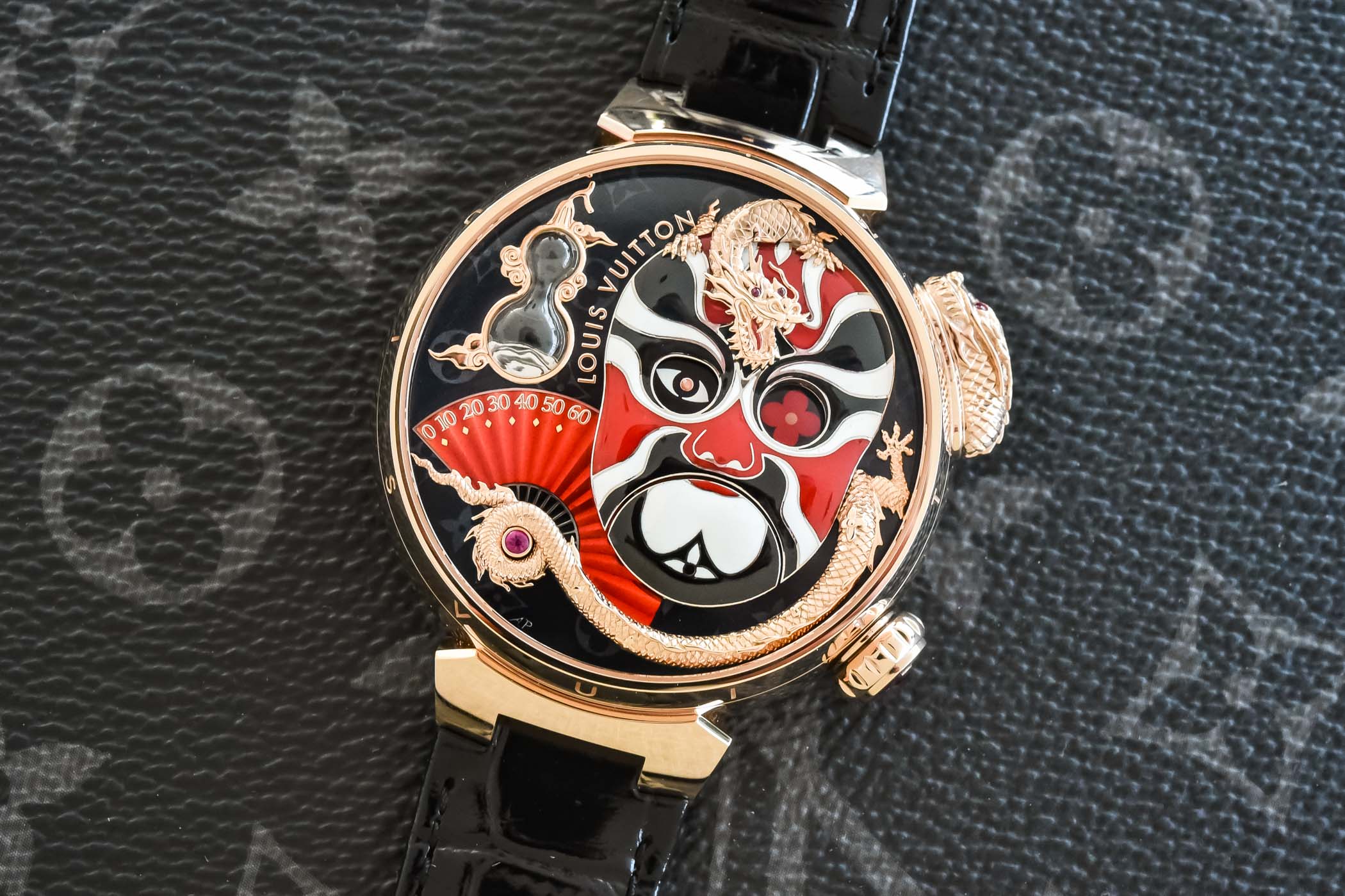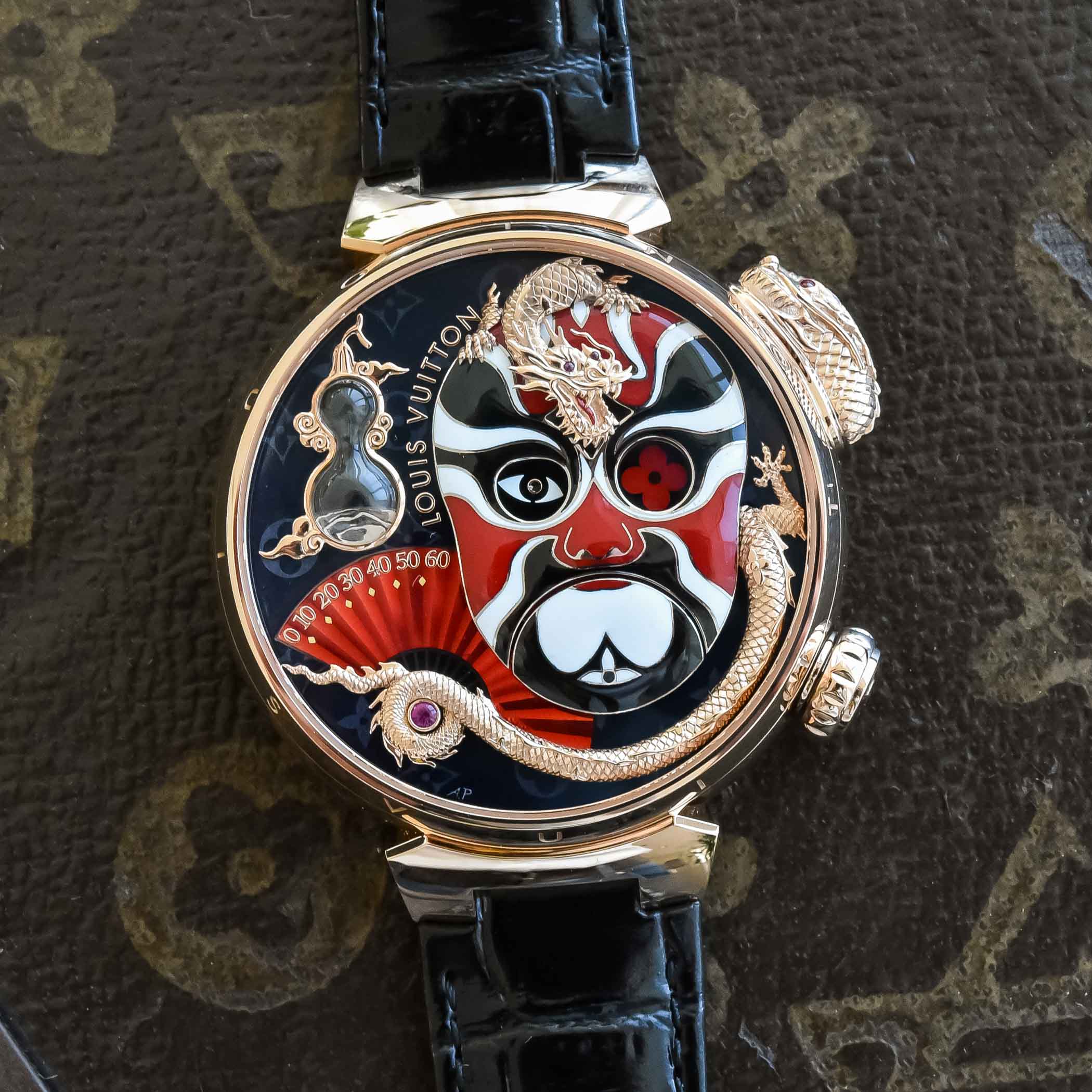Forget what you think about luxury branded watches. What Louis Vuitton does with its haute horlogerie collection, created at La Fabrique du Temps, is nothing else than spectacular, mesmerizing and rather unique within the spectrum of the industry. It is next-level high-end watchmaking, creativity and with an almost unique level of customisation. The 2021 Louis Vuitton Carpe Diem watch, an expressive take on the Vanitas, with its display animated thanks to several jacquemarts, was an eye-opening moment in the life of LV watches. This gave us the wish to understand what’s hidden behind the doors of LFT, the watchmaking atelier of Louis Vuitton. Coinciding with the launch of a new highly-complex and ultra-creative watch, the Tambour Opera Automata, we go behind the scenes of LV’s high-watchmaking, talking to master watchmaker Michel Navas to understand what stands behind the incredible dial of this animated watch inspired by Chinese culture. Something that you must see in the video on top of this article!
From trunks to watches… Louis Vuitton’s incursion into the watchmaking scene truly started about two decades ago, with the creation of the Tambour watch. From there, we could have expected the luxury giant to remain rather classic with its strategy, by offering LV-branded luxury products. But in fact, this would be extremely reductive. Louis Vuitton had other ambitions for its watchmaking division, even more since a couple of years… And the idea to play at the very highest level led to an encounter and commission with La Fabrique du Temps (LFT), a Geneva-based atelier headed by the hugely talented watchmakers Michel Navas and Enrico Barbasini – now fully integrated within the LV family.

LFT has multiple talents in-house, and several fields of expertise. Minute repeaters, skeleton movements, tourbillons… There’s another one that is, according to us here at MONOCHROME, even more important, and a rare one within the watchmaking industry: automatons and jacquemarts. The Tambour Carpe Diem, a watch that was acclaimed by the industry and won the Audacity Prize at the Grand Prix de l’Horlogerie de Genève in 2021, was a true eye-opening release that put the brand on the map of high-end watchmaking, with its incredible combination of creativity and mechanical ingenuity. An expressive, contemporary take on the concept of Vanitas, it offered a complex dial structure where the display of the time, through jumping and retrograde indications, was done thanks to a series of automatons or jacquemarts, on demand. This year, Louis Vuitton has left Europe and embarked on a new journey in China, the land of Bian Lian, with the new Tambour Opera Automata.
The inspiration behind this watch is bold and it won’t speak to everyone. But let me make one comment. We’re here talking about a commissioned watch, a piece unique that serves as a demonstration of savoir-faire. Almost everything is possible within La Fabrique du Temps Louis Vuitton, and not only the customisation of some of the elements of the habillage, but also the display and the mechanics driving it. So look at this watch from a technical perspective – even though I must admit, there’s something truly spectacular and fascinating to this incredible intricate dial.
Chinese culture… This is what drove the creation of this watch. And to be precise, Bian Lian, the “art of changing masks” characteristic of the Sichuan Opera, where performers wear vividly coloured costumes and masks, changing from one face to another almost instantaneously with the swipe of a fan, a movement of the head, or wave of the hand, to the sound of a quick, dramatic music. During the opera, performers can put on up to twenty different masks in a fraction of a second, revealing their wide range of expressions. The Louis Vuitton Tambour Opera Automata brings this art to its dial, not only by creating a scenery that is visually identical, but also by putting his mask on, and changing faces thanks to a series of jacquemarts.

Originally, jacquemarts were automata designed to strike the hour on church bells. When watchmakers miniaturised them on watches, they became essentially decorative, animating dials with theatrical scenes, while the time was still traditionally marked by classic hands. The Tambour Opera Automata goes further into the complex art of jacquemarts, by making them an inherent part of the display of the time. The creation of this watch also marks the reunion of talents; Michel Navas and Enrico Barbasini, Master Watchmakers at La Fabrique du Temps for the creation of the movement, and Anita Porchet, Master Enameller, and Dick Steenman, Master Engraver, decorated the timepiece.
The dial of the Tambour Opera Automata is characterized by an oversized Bian Lian mask, as well as a dragon’s head and tail, and finally a calabash gourd. The time is indicated by means of jumping hours and retrograde minutes, but only after a spectacle has happened. In normal mode, all indications are hidden and at rest. When the latch is pushed, the engraved pink gold dragon’s head rises to reveal the jumping hours inscribed on the forehead of the cloisonné enamel Bian Lian, while its tail indicates the retrograde minutes.

Thanks to five animations and a mesmerising 16-second watchmaking spectacle, the whole dial of the watch animates and the mask’s expression changes dramatically. Its eyebrows frown, its eyelid closes over its left eye, and the pupil of its right eye retracts to reveal a pointed Monogram flower. Going from joy to sadness through the movement of its chin, the Bian Lian mask expresses a wide range of emotions. And this is fully explained in the video on top of the article, which also shows the incredible mechanics behind this display, with its patented jacquemarts.
Powering this highly-complex series of animations is a movement developed and assembled by La Fabrique du Temps, the hand-wound calibre LV 525. Made of 426 components, it beats at 3Hz and stores a rather impressive power reserve of 100 hours. The back reveals another mask with contrasting shot-blasted and mirror-polished surfaces, and a fine decoration of all technical parts.

Moving to the habillage of the Louis Vuitton Tambour Opera Automata, it is housed in a spectacular take on LV’s signature Tambour watch, made from polished 18k pink gold, measuring 46.8mm in diameter, with a 14.42mm thickness. The most impressive part is, without a doubt, the push button of the automaton depicting a dragon’s head, as well as the winding crown adorned with a champlevé enamel fan. The watch is worn on a black alligator strap, closed by a pink gold double folding buckle.

The dial of the Tambour Opera Automata, apart from the animations we’ve explained above, is nothing short of spectacular either in terms of execution. Crafted in white, red and black cloisonné enamel separated with white gold threads, the mask has been created by the master enameller Anita Porchet. The fan that sits under the retrograde minute indication was done thanks to a champlevé enamel technique, which involves removing some material from the surface in order to deposit colour pigments. The pink-gold dragon and its tail have been created by Swiss engraver Dick Steenman, and later adorned with cabochon-cut rubies. Finally, the power reserve is indicated by the calabash gourd, made of curved glass.
The Louis Vuitton Tambour Opera Automata is a truly fascinating and mechanically spectacular watch. It is bold, ultra-expressive and yet manages to bring emotions without ostentation. As said, it is a unique piece and anything can be made at LFT. As long as your wallet is thick enough. Expect around EUR 450,000 for such a watch.
For more details, make sure to check the video at the beginning of this article and visit louisvuitton.com.
https://monochrome-watches.com/video-review-louis-vuitton-tambour-opera-automata-inside-lv-la-fabrique-du-temps/




